Continued from page 1
Benchmarking and Performance Results
We will cover our benchmarking first and then go to real-world application testing. Like prior reviews, we have utilized SketchUp as not just a very popular design modeling tool in AEC, but also as a proxy for OpenGL-based BIM applications, or OpenGL shaded with edges-based viewport rendering with or without anti-aliasing. We also ran Creo and Solidworks subtests as part of SPECviewperf 2020. Here are the tests and benchmarks we go through:
- CompuBench — OpenCL (download link)
- GFXbench — OpenGL only test(s) (download link)
- VRMark — virtual reality benchmark (download link)
- SPECviewperf 2020 V3 (selected OpenGL CAD tests) — (download link)
- SketchUp TTD FPS — OpenGL 3.1 based FPS tests using our own test files
We also gave Twinmotion a spin using the same file we have used in our last two prior GPU tests. (see the third page in this report).
Summary Conclusions
AMD’s Radeon Pro W6400 is fundamentally intended for three groups of users: (1) mainstream modern business users who benefit from GPU performance in apps like video conferencing, photo-editing, and marketing applications rich in graphic media, including video, (2) 2D CAD designers and engineers, and (3) budget-conscious professionals in need of workstation-class GPUs.
What we are focused on are these last two groups. Those who do medium to extreme 3D CAD workloads are going to be better served by AMD’s Radeon Pro W6600. But when we write “better” it needs qualifications. In the AEC space, BIM and 3D modeling workloads in OpenGL with shaded, shaded + edges, with and without anti-aliasing, are actually economically better served by the W6400 than the W6600 on a performance per dollar basis. This includes MCAD users working in tools like PTC Creo and Dassault Solidworks and similar OpenGL tools (see our specific notes regarding what types of OpenGL features are in the viewport for each test).
Benchmarks Results
We retested the AMD Radeon Pro W6600 at the same time we tested the Radeon Pro W6400. As you will see, in general across our typical cross-platform benchmarks we favor, the big-sister W6600 performs twice as fast if not faster than the W6400. It’s a battle between 768 Stream Processors versus 1792 Stream Processors.
CompuBench
We run the Catmull-Clark SubDivision Surfaces Level 5 test and the Subsurface Scattering rendering tests in this GPU-compute oriented, OpenCL benchmark suite. The algorithms in these tests are very applicable to real-world professional 3D computer graphics.

Chart 1: CompuBench Catmull-Clark SubDivision test using OpenCL. Longer bars are better. (Image: Architosh / All rights reserved.)
The algorithm tested here recursively breaks down surfaces into further surfaces to achieve “curved surfaces.” Software using the Catmull-Clark algorithm includes most leading CAD and 3D software tools from AutoCAD to Maya to Rhino. The W6600 GPU is essentially 2x faster than the W6400 GPU.
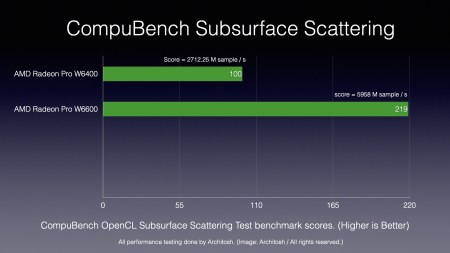
Chart 2: CompuBench Subsurface Scattering Rendering, test using OpenCL. Longer bars are better. (Image: Architosh / All rights reserved.)
When it came to this particular rendering technique, Subsurface scattering (SSS), the big sibling AMD GPU again did 2x the performance of the subject test GPU. SSS is about how light penetrating the surface of a translucent object will scatter by interacting with the material before it exits the material on the other side. Shining a light behind your fingers is a real-life example of subsurface scattering. But the rendering test results look like this below. (Image 1)
Let’s look at some other tests, using OpenGL.
GFXBench
We only ran the GFXBench Tessellation OpenGL tests from this suite for this review. Tessellation is a critical technology in OpenGL performance and real-time rendering. Datasets of polygons are tessellated into triangles, and the process is offloaded onto GPU hardware to enable the smoothing of objects in real-time.
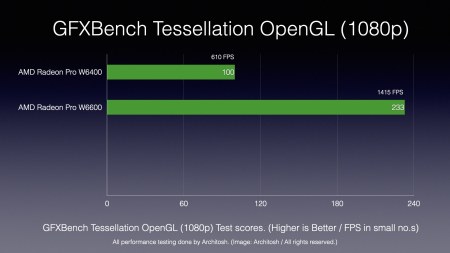
Chart 3: GFXBench Tessellation OpenGL test. Longer bars are better. (Image: Architosh / All rights reserved.)
With only 42 percent of the stream processors and a bit over 1/3 the W6600’s TFLOP rate, it is very understandable why the Radeon Pro W6400 is half as fast or slightly less than its bigger sibling GPU on this computational function. This gives you an indication of where it sits in terms of rendering pipeline performance.
VRMark
AMD says the Radeon Pro W6400 is VR-Ready and our tests proved this case. The Orange Room test is the least demanding test and is designed to test VR performance today. So for headsets today the W6400 meets the mark.
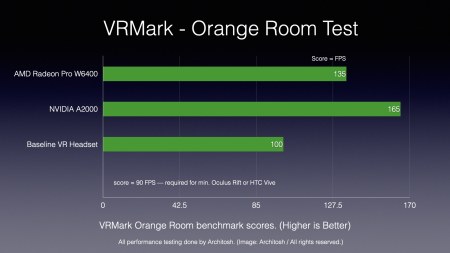
Chart 4: VRMark scores for the AMD Radeon Pro W6400 versus the NVIDIA A2000. Longer bars are better. (Image: Architosh / All rights reserved.)
The minimum FPS rate for powering the Oculus Rift or the HTC Vive (both devices that have been superceded but are variously available) a GPU needs to generate more than 90 FPS on this test. The NVIDIA A2000, a GPU costing twice as much, did well at 165 FPS. The AMD Radeon Pro W6400 scored 135 FPS. On a performance dollar basis, the W6400 slightly outperforms the NVIDIA A2000, but it neither matches it nor its bigger sibling W6600 in absolute performance.
SPECviewperf 2020 V3
For this review, we endeavored to add more information applicable to manufacturing CAD (MCAD) users. So we tested the Radeon Pro W6400 and retested AMD Radeon Pro W6600 we had recently reviewed on the SPECviewperf 2020 V3 benchmark.
SPECviewperf is widely considered the worldwide standard for measuring graphics performance based on professional applications. (learn more here). The benchmark test suite crunches through various “viewsets” from actual professional CAD and 3D applications including Autodesk 3ds Max, Autodesk Maya, Solidworks, Catia, Creo, and Siemens NX–without the need to have those applications installed on your machine.
Creo and Solidworks
In our tests, we selected viewsets for PTC Creo and Solidworks to focus solely on OpenGL 4.6 based MCAD systems.
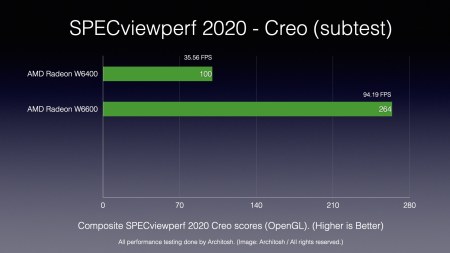
Chart 5: SPECviewperf 2020 V3. Selected viewsets for Creo. Longer bars are better. (Image: Architosh / All rights reserved.)
So the first chart above shows the composite SPECviewperf 2020 scores for Creo. While the AMD Radeon Pro W6600 clearly out-classes its smaller sibling, the new Radeon Pro W6400 tells a more interesting story when we drill down into the details of specific subtests. (see charts below the next chart).

Chart 6: SPECviewperf 2020 V3 focused on Solidworks. Longer bars are better. (Image: Architosh / All rights reserved.)
Again with Solidworks composite scores, the AMD Radeon Pro W6400 is out-classed by its bigger sibling, but not nearly as much as you might imagine based on TFLOPs and cores on the chip.
Shaded with Edges Tests
These MCAD industry tools are widely used with variously different rendering modes, but the dominant mode is working with models with “shaded and edges” rendered. This is the same way most AEC professionals work with BIM or 3D models. Transparency is also important, but reflections, bumps, textures, and anti-aliasing are of lesser importance and less commonly used.
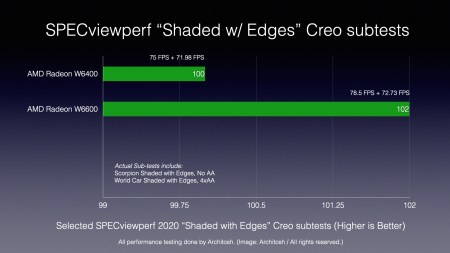
Chart 7: SPECviewperf 2020 V3 subset with Creo with Shaded w/ Edges. Longer bars are better. Reader beware, the number in the bar is more important than the visual length of the bar in the chart. (Image: Architosh / All rights reserved.)
In the Creo subtests, there are 13 separate tests. One test is called Scorpion, Shaded with Edges, no AA (anti-aliasing). This is a render mode that a large percentage of users will employ. Another common mode is the same thing but with anti-aliasing turned on, to smooth edges. World Car Shaded with Edges, 4xAA turned on is just such a case. (see images 2-3 below). In both of these sub-tests, we see the Radeon Pro W6400 essentially nearly as performant as the Radeon Pro W6600, only off by about 4 percentage points max. (see chart 7 above).
However, in another sub-test called Scorpion, Shaded, Reflections, Bump transparency with color, 8xAA, we see the W6600 is nearly twice as fast. (see image below). Another view of the Scorpion model with HiddenLine, 8xAA, showed the W6400 GPU to be 58 percent as fast as its big sibling W6600.
What these Creo subtests demonstrate is that the W6400 GPU performs essentially at the same performance as its big sister W6600 GPU when working with models in viewports rendered in basic OpenGL shaded views with edges mode, with or without anti-aliasing turned on. This helps also explain the small differences between these two sibling GPUs with SketchUp models in many cases.
Economic Metrics
What we see above in the SPECviewperf 2020 tests is that in OpenGL 4.6 viewports rendered with complexity such as reflections, shadows (notice the shadow added in the image above), bumps, et cetera, is that the W6400 is outclassed by a mid-tier GPU like the W6600, which is what you would expect. So the type of OpenGL rendering can really matter in performance.
A majority of MCAD and AEC CAD/BIM users are working in viewports with shaded with edges mode with or without AA. So this is where the economics of the AMD Radeon Pro W6400 become interesting. Even in a mixed-mode where there is a blended mix of shaded with edges OpenGL rendered viewport work with more complex OpenGL rendered viewport work, the performance on a dollar cost basis is quite impressive.

Chart 8: SPECviewperf — Composite Performance (CU) per Dollar. Shorter bars are better in blue bar charts. In this economics-oriented chart, the cost of one compute unit (CU) score in our selected Creo + Solidworks viewsets is shown above in USD. (Image: Architosh / All rights reserved.)
On the composite Creo + Solidworks viewsets, the Radeon Pro W6400 has a better return on investment in terms of performance per dollar. And for those who do almost all their work in more simplified OpenGL rendered with shaded and edges only viewports, the economics then strongly favor the W6400 over the W6600. (see below).

Chart 9: SPECviewperf — Shaded & Edge Performance (CU) per Dollar. Shorter bars are better in blue charts. In this economics-oriented chart, the cost of one compute unit (CU) score in our selected Creo only Shaded with Edges subtests shows a marked advantage in Performance per Dollar. (Image: Architosh / All rights reserved.)
The point of these last two charts isn’t to drive potential users away from the AMD Radeon Pro W6600 GPU, but to make the point that for a large majority of CAD users, depending on the type of work they do and how it is rendered in their OpenGL applications, the Radeon Pro W6400 will perform equally as well. This applies to AEC users, to some degree, as we see on the next page.
next page: Twinmotion, SketchUp, and Conclusions / Recommendations

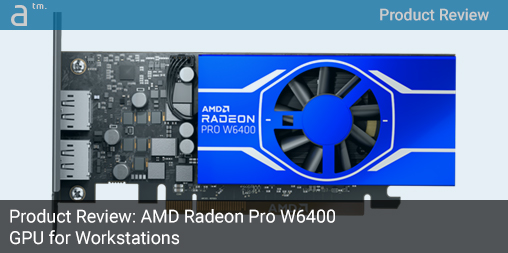







Reader Comments
Comments for this story are closed